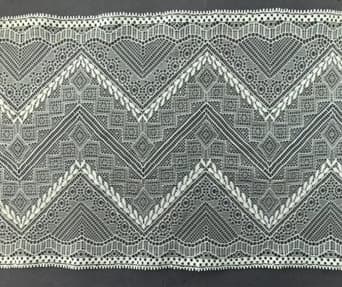 Lace trim serves various purposes in sewing projects, adding elegance, charm, and decorative flair to a wide range of items.
Lace trim serves various purposes in sewing projects, adding elegance, charm, and decorative flair to a wide range of items.
Here are some common uses of lace trim in sewing:
Garment Embellishment: Lace trim is frequently used to embellish garments such as dresses, blouses, skirts, and lingerie. It adds delicate detailing to necklines, sleeves, hems, and other areas, enhancing the overall aesthetic appeal of the garment.
Home Décor: Lace trim is popular for decorating Home Textiles, including curtains, pillowcases, tablecloths, and bedding. It can be sewn along the edges or inserted into seams to create a decorative border or accentuate the design of these items.
Accessories: Lace trim is often incorporated into accessories such as scarves, shawls, handkerchiefs, and bags. It adds a touch of femininity and sophistication to these accessories, elevating their style and visual appeal.
Craft Projects: Lace trim is widely used in various craft projects, including scrapbooking, card making, and DIY decorations. It can be glued, sewn, or adhered to paper, fabric, or other materials to create intricate designs and embellishments.
Special Occasion Wear: Lace trim is commonly employed in sewing formal and special occasion wear such as wedding dresses, bridesmaid gowns, prom dresses, and evening wear. It adds a romantic and luxurious touch to these garments, making them suitable for elegant events.
Children's Clothing: Lace trim is often used in sewing children's clothing, including dresses, rompers, and pajamas. It adds a sweet and playful element to kids' apparel, especially for special occasions or dress-up outfits.
Vintage and Retro Fashion: Lace trim is frequently featured in vintage and retro-inspired fashion designs. It can be used to recreate the look of bygone eras, such as Victorian, Edwardian, or 1920s fashion, adding authenticity and charm to modern garments.
Costume Design: Lace trim is an essential component in costume design for theater, film, and cosplay. It can be used to create period costumes, character costumes, and fantasy outfits, helping to bring characters to life with intricate detailing and texture.
Lingerie and Intimate Apparel: Lace trim is a staple in the design of lingerie, underwear, and intimate apparel. It adds a touch of romance and sensuality to bras, panties, camisoles, and sleepwear, enhancing their feminine allure.
Personalized Gifts: Lace trim can be used to personalize gifts such as handkerchiefs, towels, and baby blankets. It adds a thoughtful and elegant touch to these items, making them suitable for special occasions such as weddings, baby showers, or birthdays.
In summary, lace trim is a versatile and decorative element in sewing projects, serving a wide range of purposes from garment embellishment to home décor, accessories, craft projects, and special occasion wear. Its delicate and intricate appearance adds beauty and sophistication to a variety of items, making it a beloved choice for sewists and crafters alike.
When it comes to sewing lace trim, here are some key techniques to keep in mind:
Choosing the Right Needle and Thread: Select a fine needle appropriate for the weight and type of lace you're using. Use a matching thread color for a seamless finish.
Prepping the Lace: Before sewing, you may want to press the lace trim with a cool iron to remove any wrinkles. Be gentle to avoid damaging delicate lace.
Pin or Baste the Lace: Depending on your preference, you can either pin or baste the lace trim onto the fabric before sewing. This helps to keep the lace in place and ensures even stitching.
Stitching Techniques: Use a straight stitch or a narrow zigzag stitch to attach the lace trim to the fabric. Sew along the edges of the lace, ensuring that the stitching is neat and even.
Adjusting Stitch Length: Depending on the density of the lace and the effect you want to achieve, you may need to adjust the stitch length. Test on a scrap piece of fabric to determine the best stitch length for your project.
Handling Corners and Curves: When sewing lace trim around corners or curves, go slowly and pivot the fabric as needed to maintain smooth stitching. You may need to clip into the seam allowance of the fabric to help the lace lay flat.
Finishing Ends: To finish the ends of the lace trim neatly, you can either overlap the ends slightly and stitch them together or fold the ends under and stitch in place. Trim any excess lace for a clean finish.
Securing Loose Threads: Once you've finished sewing, secure any loose threads by tying them off and trimming them close to the fabric. This helps prevent unraveling and ensures a tidy final result.
Pressing the Finished Piece: Finally, press the fabric and lace trim with a cool iron to set the stitches and give the finished piece a polished look. Be sure to use a pressing cloth to protect delicate lace from direct heat.
Practice and Patience: Sewing lace trim requires practice and patience, especially when working with intricate designs or delicate fabrics. Take your time, experiment with different techniques, and don't be afraid to make adjustments as needed.